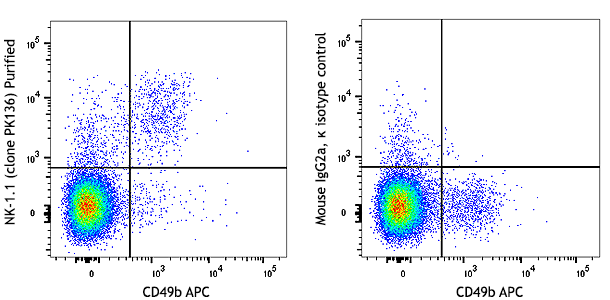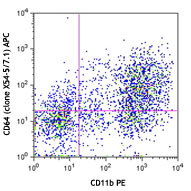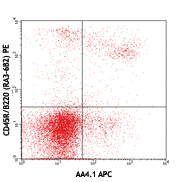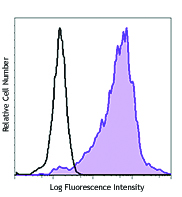- Regulatory Status
- RUO
- Other Names
- CCL5 (RANTES),CCL20 (MIP-3α),CCL11 (Eotaxin-1),CCL17 (TARC),CXCL1 (KC),CCL2 (MCP-1),CXCL9 (MIG),CXCL10 (IP-10),CCL3 (MIP-1α),CCL4 (MIP-1β),CXCL13 (BLC),CXCL5 (LIX),CCL22 (MDC)
- Ave. Rating
- Submit a Review
- Product Citations
- publications
| Cat # | Size | Price | Quantity | Save | ||
|---|---|---|---|---|---|---|
| 740007 | 100 tests | 1409€ | ||||
Chemotactic cytokines or chemokines play pivotal roles in various processes such as immune surveillance, organ development, angiogenesis, and immune responses. Expression profiling of chemokines, especially those involved in inflammation and immune disorders, is important in achieving a deeper understanding of disease states.
The Mouse Proinflammatory Chemokine panel is a multiplex bead-based assay panel, using fluorescence-encoded beads suitable for use on various flow cytometers. This panel allows simultaneous quantification of 13 Mouse chemokines, including MCP-1 (CCL2), RANTES (CCL5), IP-10 (CXCL10), Eotaxin (CCL11), TARC (CCL17), MIP-1α (CCL3), MIP-1β (CCL4), MIG (CXCL9), MIP-3α (CCL20), LIX (CXCL5), KC (CXCL1), BLC (CXCL13) and MDC (CCL22). This assay panel provides higher detection sensitivities and broader dynamic ranges than traditional ELISA methods. The panel has been validated by detecting expected changes in biological samples.
A Mix and Match system is available to customize assays for specificities within this proinflammatory chemokine panel.
Kit Contents
- Kit Contents
-
- Setup Beads: PE Beads
- Setup Beads: Raw Beads
- Capture Beads
- Detection Antibodies
- Standard Cocktail, Lyophilized
- SA-PE
- Matrix B, Lyophilized
- Assay Buffer
- Wash Buffer
- Filter Plate
- Plate Sealers
Product Details
- Verified Reactivity
- Mouse
- Application
-
Multiplex
Learn more about LEGENDplex™ at biolegend.com/legendplex
Download the LEGENDplex™ software here. - Additional Product Notes
-
View more applications data using this product with relevant biological samples, measuring cytokines in response to stimulation conditions, and to study immune checkpoints and the immune response.
-
Application References
(PubMed link indicates BioLegend citation) - Product Citations
-
- Materials Not Included
-
- Flow Cytometer
- Pipettes and Tips
- Reagent Reservoirs for Multichannel Pipettes
- Polypropylene Microfuge Tubes
- Vortex Mixer
- Sonicator
- Plate Shaker
- A Vacuum Filtration Unit and a Vacuum Source (if using filter plates)
- Manual
Antigen Details
- Biology Area
- Cell Biology, Immunology, Innate Immunity, Neuroinflammation, Neuroscience
- Molecular Family
- Cytokines/Chemokines
- Gene ID
- 20303 View all products for this Gene ID 20304 View all products for this Gene ID 20292 View all products for this Gene ID 20295 View all products for this Gene ID 20297 View all products for this Gene ID 14825 View all products for this Gene ID 20311 View all products for this Gene ID 20299 View all products for this Gene ID 17329 View all products for this Gene ID 15945 View all products for this Gene ID 55985 View all products for this Gene ID
Related Pages & Pathways
Pages
Related FAQs
- If I don't have a vacuum, how do I remove the liquid from my plate?
-
If you do not have a vacuum, the assay should be run in a V-bottom plate. After centrifugation using a swinging-bucket rotor with a plate adaptor, you can remove the liquid by flicking the plate quickly, dumping the contents into a sink, and patting it dry carefully on a stack of clean paper towels without losing the beads. Alternatively, you can remove the liquid by using a pipette.
- Should I perform the assay with the filter plates or with V-bottom plates?
-
Filter plates or V-bottom plates have been included in some kits for your convenience. A vacuum filtration unit is required to work with the filter plates. However, if you don’t have access to a vacuum manifold or if you prefer, then you can use the V-bottom plates and follow the recommended assay protocols for the type of plates you choose. All plates should be made from low binding polypropylene. Polystyrene ELISA or cell culture plates should not be used.
- After I finish the staining process, how long can I wait before reading my LEGENDplex™ samples?
-
The samples can be kept overnight at 4°C while being protected from exposure to light and be read the next day. There may be a decrease in signal, but overall, the assay results should not be affected. Storing the samples for extended periods of time is not recommended, as it could lead to further reductions in signal.
- What is the shelf life of LEGENDplex™ kits?
-
LEGENDplex™ kits are guaranteed for 6 months from the date of receipt, but may have a shelf life of up to 2 years from the date of manufacture.
- Is special software required for data analysis?
-
Typically flow cytometers generate output files in FCS format (e.g. FCS 2.0, 3.0, or 3.1) and in some cases in list mode file format (LMD). Other software may be available to analyze FCS files. Data generated using LEGENDplex™ kits can be analyzed using the freely available LEGENDplex™ data analysis software. Please check our website for the most updated versions of the software.
 Login / Register
Login / Register 












Follow Us